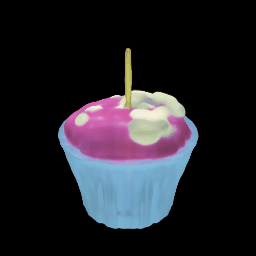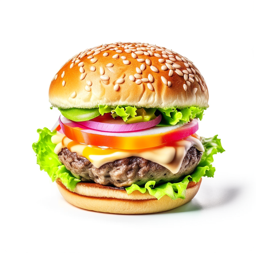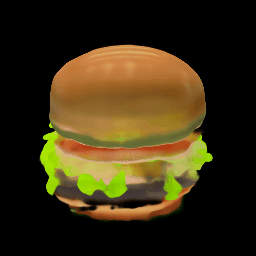Shap-E
The Shap-E model was proposed in Shap-E: Generating Conditional 3D Implicit Functions by Alex Nichol and Heewon Jun from OpenAI.
The abstract from the paper is:
We present Shap-E, a conditional generative model for 3D assets. Unlike recent work on 3D generative models which produce a single output representation, Shap-E directly generates the parameters of implicit functions that can be rendered as both textured meshes and neural radiance fields. We train Shap-E in two stages: first, we train an encoder that deterministically maps 3D assets into the parameters of an implicit function; second, we train a conditional diffusion model on outputs of the encoder. When trained on a large dataset of paired 3D and text data, our resulting models are capable of generating complex and diverse 3D assets in a matter of seconds. When compared to Point-E, an explicit generative model over point clouds, Shap-E converges faster and reaches comparable or better sample quality despite modeling a higher-dimensional, multi-representation output space.
The original codebase can be found at openai/shap-e.
Make sure to check out the Schedulers guide to learn how to explore the tradeoff between scheduler speed and quality, and see the reuse components across pipelines section to learn how to efficiently load the same components into multiple pipelines.
Usage Examples
In the following, we will walk you through some examples of how to use Shap-E pipelines to create 3D objects in gif format.
Text-to-3D image generation
We can use [ShapEPipeline] to create 3D object based on a text prompt. In this example, we will make a birthday cupcake for :firecracker: diffusers library's 1 year birthday. The workflow to use the Shap-E text-to-image pipeline is same as how you would use other text-to-image pipelines in diffusers.
import torch
from diffusers import DiffusionPipeline
device = torch.device("cuda" if torch.cuda.is_available() else "cpu")
repo = "openai/shap-e"
pipe = DiffusionPipeline.from_pretrained(repo, torch_dtype=torch.float16)
pipe = pipe.to(device)
guidance_scale = 15.0
prompt = ["A firecracker", "A birthday cupcake"]
images = pipe(
prompt,
guidance_scale=guidance_scale,
num_inference_steps=64,
frame_size=256,
).images
The output of [ShapEPipeline] is a list of lists of images frames. Each list of frames can be used to create a 3D object. Let's use the export_to_gif utility function in diffusers to make a 3D cupcake!
from diffusers.utils import export_to_gif
export_to_gif(images[0], "firecracker_3d.gif")
export_to_gif(images[1], "cake_3d.gif")
Image-to-Image generation
You can use [ShapEImg2ImgPipeline] along with other text-to-image pipelines in diffusers and turn your 2D generation into 3D.
In this example, We will first genrate a cheeseburger with a simple prompt "A cheeseburger, white background"
from diffusers import DiffusionPipeline
import torch
pipe_prior = DiffusionPipeline.from_pretrained("kandinsky-community/kandinsky-2-1-prior", torch_dtype=torch.float16)
pipe_prior.to("cuda")
t2i_pipe = DiffusionPipeline.from_pretrained("kandinsky-community/kandinsky-2-1", torch_dtype=torch.float16)
t2i_pipe.to("cuda")
prompt = "A cheeseburger, white background"
image_embeds, negative_image_embeds = pipe_prior(prompt, guidance_scale=1.0).to_tuple()
image = t2i_pipe(
prompt,
image_embeds=image_embeds,
negative_image_embeds=negative_image_embeds,
).images[0]
image.save("burger.png")
we will then use the Shap-E image-to-image pipeline to turn it into a 3D cheeseburger :)
from PIL import Image
from diffusers.utils import export_to_gif
repo = "openai/shap-e-img2img"
pipe = DiffusionPipeline.from_pretrained(repo, torch_dtype=torch.float16)
pipe = pipe.to("cuda")
guidance_scale = 3.0
image = Image.open("burger.png").resize((256, 256))
images = pipe(
image,
guidance_scale=guidance_scale,
num_inference_steps=64,
frame_size=256,
).images
gif_path = export_to_gif(images[0], "burger_3d.gif")
Generate mesh
For both [ShapEPipeline] and [ShapEImg2ImgPipeline], you can generate mesh output by passing output_type as mesh to the pipeline, and then use the [ShapEPipeline.export_to_ply] utility function to save the output as a ply file. We also provide a [ShapEPipeline.export_to_obj] function that you can use to save mesh outputs as obj files.
import torch
from diffusers import DiffusionPipeline
from diffusers.utils import export_to_ply
device = torch.device("cuda" if torch.cuda.is_available() else "cpu")
repo = "openai/shap-e"
pipe = DiffusionPipeline.from_pretrained(repo, torch_dtype=torch.float16, variant="fp16")
pipe = pipe.to(device)
guidance_scale = 15.0
prompt = "A birthday cupcake"
images = pipe(prompt, guidance_scale=guidance_scale, num_inference_steps=64, frame_size=256, output_type="mesh").images
ply_path = export_to_ply(images[0], "3d_cake.ply")
print(f"saved to folder: {ply_path}")
Huggingface Datasets supports mesh visualization for mesh files in glb format. Below we will show you how to convert your mesh file into glb format so that you can use the Dataset viewer to render 3D objects.
We need to install trimesh library.
pip install trimesh
To convert the mesh file into glb format,
import trimesh
mesh = trimesh.load("3d_cake.ply")
mesh.export("3d_cake.glb", file_type="glb")
By default, the mesh output of Shap-E is from the bottom viewpoint; you can change the default viewpoint by applying a rotation transformation
import trimesh
import numpy as np
mesh = trimesh.load("3d_cake.ply")
rot = trimesh.transformations.rotation_matrix(-np.pi / 2, [1, 0, 0])
mesh = mesh.apply_transform(rot)
mesh.export("3d_cake.glb", file_type="glb")
Now you can upload your mesh file to your dataset and visualize it! Here is the link to the 3D cake we just generated https://huggingface.co/datasets/hf-internal-testing/diffusers-images/blob/main/shap_e/3d_cake.glb
ShapEPipeline
[[autodoc]] ShapEPipeline - all - call
ShapEImg2ImgPipeline
[[autodoc]] ShapEImg2ImgPipeline - all - call
ShapEPipelineOutput
[[autodoc]] pipelines.shap_e.pipeline_shap_e.ShapEPipelineOutput



